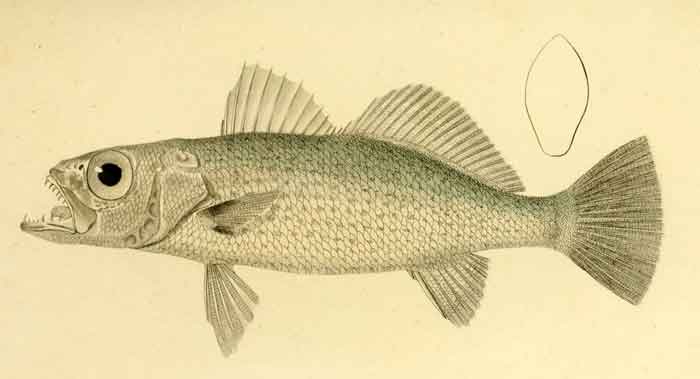Superregnum: Eukaryota
Cladus: Unikonta
Cladus: Opisthokonta
Cladus: Holozoa
Regnum: Animalia
Subregnum: Eumetazoa
Cladus: Bilateria
Cladus: Nephrozoa
Superphylum: Deuterostomia
Phylum: Chordata
Subphylum: Vertebrata
Infraphylum: Gnathostomata
Megaclassis: Osteichthyes
Superclassis/Classis: Actinopterygii
Classis/Subclassis: Actinopteri
Subclassis/Infraclassis: Neopterygii
Infraclassis: Teleostei
Megacohors: Osteoglossocephalai
Supercohors: Clupeocephala
Cohors: Euteleosteomorpha
Subcohors: Neoteleostei
Infracohors: Eurypterygia
Sectio: Ctenosquamata
Subsectio: Acanthomorphata
Divisio/Superordo: Acanthopterygii
Subdivisio: Percomorphaceae
Series: Eupercaria
Ordo: Perciformes
Subordo: Percoidei
Superfamilia: Percoidea
Familia: Sciaenidae
Genus: Odontoscion
Species: O. dentex – O. eurymesops – O. xanthops
Name
Odontoscion Gill, 1862
References
Odontoscion – Taxon details on Integrated Taxonomic Information System (ITIS).
Odontoscion species list in FishBase,
Froese, R. & Pauly, D. (eds.) 2024. FishBase. World Wide Web electronic publication, www.fishbase.org, version 02/2024.
Vernacular names

Odontoscion dentex
Odontoscion is a genus of marine ray-finned fish belonging to the family Sciaenidae, the croakers and drums. These fishes are found in the Western Atlantic and Eastern Pacific Oceans.
Taxonomy
Odontoscion was first proposed as a genus in 1862 by the American biologist Theodore Gill with its type species, and only species, designated as Corvina dentex[1] which had originally been described in 1830 by Georges Cuvier from Port-au-Prince, Haiti.[2] This genus has been placed in the subfamily Stelliferinae by some workers,[3] but the 5th edition of Fishes of the World does not recognise subfamilies within the Sciaenidae, which it places in the order Acanthuriformes.[4]
Etymology
Odontoscion is a combination of odontos, meaning teeth, a referenece to the 6 or 7 large canine-like teeth on each side of both jaws of the type species, with scion, a modern Greek name of the shi drum (Umbrina cirrosa), which Gill chose in preference to “sciaena” because he thought that it sounded better, similar to his coining of Cynoscion.[5]
Species
Odontoscion contains three valid species:[6]
Odontoscion dentex (Cuvier, 1830) (Reef croaker)
Odontoscion eurymesops (Heller & Snodgrass, 1903) (Galapagos croaker)
Odontoscion xanthops Gilbert, 1898 (Yelloweye croaker)
Characteristics
Odontoscion croakers have short, rather oblong and compressed bodies,[7] with a smoothly arched dorsal profile.[8] They have a low head with a conical snout and a large eye. There is a small protuberance on the tip of the lower jaw. The mouth is moderately large, upwards pointing and has a protruding lower jaw. There is a row of large teeth in the front of each jaw, at least some of which may be canine-like. The snout has 8 pores and there are a further 4 or 5 pores on the chin, which does not have a barbel. The preoperculum is smooth. The dorsal fin is supported by 10 or 11 spines before the incision and by a single spine and between 23 and 26 soft rays to the rear of the incision, The anal fin has 2 spines and 8 or 9 soft rays, with the second spine being 75% of the length of the first soft ray.[7] These fishes have maximum published total lengths of 25 cm (9.8 in) in the case of O. eurymesops and 30 cm (12 in) in the other two species.[6]
Distribution and habitat
Odontoscion are found off the Americas with a single species, O. dentex in the Western Atlantic Ocean occurring from Florida and Cuba south to Brazil.[9] The other two species are found in the Eastern Pacific Ocean with O. eurymesops being endemic to the Galapagos Islands and Cocos Island[10][11] while O. xanthops has a range which extends from the Gulf of California to Peru.[12] One species, O. xanthops is found in shallow coastal waters and enters estuaries and the mouths of rivers,[12] the other two species refer harder substrates such as rocks and reefs.[9][10]
References
Eschmeyer, William N.; Fricke, Ron & van der Laan, Richard (eds.). "Genera in the family Sciaenidae". Catalog of Fishes. California Academy of Sciences. Retrieved 7 June 2023.
Eschmeyer, William N.; Fricke, Ron & van der Laan, Richard (eds.). "Species in the genus Odontoscion". Catalog of Fishes. California Academy of Sciences. Retrieved 7 June 2023.
Kunio Sasaki (1989). "Phylogeny of the family Sciaenidae, with notes on its Zoogeography (Teleostei, Peciformes)" (PDF). Memoirs of the Faculty of Fishes Hokkaido University. 36 (1–2): 1–137.
J. S. Nelson; T. C. Grande; M. V. H. Wilson (2016). Fishes of the World (5th ed.). Wiley. pp. 497–502. ISBN 978-1-118-34233-6.
Christopher Scharpf & Kenneth J. Lazara, eds. (9 March 2023). "Series Eupercaria (Incertae sedis): Families Callanthidae, Centrogenyidae, Dinopercidae, Emmelichthyidae, Malacanthidae, Monodactylidae, Moronidae, Parascorpididae, Sciaenidae and Sillagidae". The ETYFish Project Fish Name Etymology Database. Christopher Scharpf and Kenneth J. Lazara. Retrieved 7 June 2023.
Froese, Rainer and Pauly, Daniel, eds. (2023). Species of Odontoscion in FishBase. February 2023 version.
"Genus: Odontoscion, Reef Croaker, Croakers". Shorefishes of the Greater Caribbean online information system. Smithsonian Tropical Research Institute. Retrieved 7 June 2023.
Labbish Ning Chao (1978). "A basis for classifying western Atlantic Sciaenidae (Teleostei: Perciformes)" (PDF). NOAA (National Oceanic and Atmospheric Administration) Technical Report NMFS (National Marine Fisheries Service). Circular No. 415.
Froese, Rainer; Pauly, Daniel (eds.) (2023). "Odontoscion dentex" in FishBase. February 2023 version.
Froese, Rainer; Pauly, Daniel (eds.) (2023). "Odontoscion eurymesops" in FishBase. February 2023 version.
Chao, L. & Espinosa-Perez, H. (2021). "Odontoscion eurymesops". IUCN Red List of Threatened Species. 2021: e.T183445A131035784. doi:10.2305/IUCN.UK.2021-1.RLTS.T183445A131035784.en. Retrieved 7 June 2023.
Froese, Rainer; Pauly, Daniel (eds.) (2023). "Odontoscion xanthops" in FishBase. February 2023 version.
Retrieved from "http://en.wikipedia.org/"
All text is available under the terms of the GNU Free Documentation License

